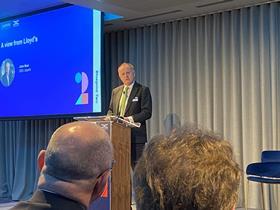Confirmed delays to Blueprint Two’s roll out have been described as a ’blessing in disguise’, however
Six months ago, Bob James - market transformation director at Lloyd’s of London - had one of the marketplace’s manual processes explained to him.

This involved a Microsoft Word document being turned into a PDF. This was then sent to the London market’s insurance bureau, where the data was keyed into a mainframe computer.
This process was miles away from James’ idea of having a tagged Microsoft Word template where data could be easily extracted.
Speaking at an event hosted by Lloyd’s and DXC Technology on 5 December 2022, James continued his story: “The only thing I could think of that was missing was the parchment paper, fountain pen and sealing wax.”
Processes like these are why Lloyd’s created its Future at Lloyd’s digital transformation initiative back in May 2019 - this culminated in the publication of Blueprint Two in November 2020.
The steps and deliverables within this plan are still being fleshed out, but Lloyd’s expects the measures within Blueprint Two to be effective in 2024.
James emphasised that Blueprint Two is ”really trying to change” the paper-based systems of old, that Lloyd’s has historically favoured.
“It’s not about delivering technology – it’s about how we change how we do business in the market to have a data first process,” he said.
Cassandra Vukorep, head of London specialty at NTT Data UK and Ireland, added that Blueprint Two is the “first significant step towards the full digitalisation of the London insurance market”.
She continued: ”It’s a crucial component of a future that Lloyd’s of London is driving forward – a better and cheaper insurance market for all.”
Sheridon Glenn, global vice-president of strategic markets and initiatives at Guidewire, is also a fan of the Blueprint Two project - he told Insurance Times that the scheme is “exciting and scary all at the same time”.
As part of Blueprint Two, Lloyd’s has been upgrading its 25-year-old, mainframe-based technology stack.
A tech stack refers to the combination of technologies a company uses to build and run an application or project.
James continued: “[Our technology stack] is not as resilient as we would like it to be and it does not sit in the cloud.
”For people that use it on a day-to-day basis, it’s a bunch of green screens that [might have] looked very familiar if we were part of the moon mission from the 1960s.”
Blessing in disguise
Although Blueprint Two is predicted to come to fruition in 2024, its roll out has been pushed back by one or two quarters, according to Lloyd’s.
For James, this delay is a “blessing in disguise”.
He explained: “It gives us more time to do testing. [This is] important to make sure that the interoperability works. But [the delay] also allows us to go live in the summer months and avoid the renewal season.”
A Lloyd’s spokesperson added: “The transformation programme is the most prominent technological and process change that has taken place in the London market, so it’s important that we take the time to deliver the right solutions for market participants and ensure they have ample time to adopt them.
“[This year] has been good for the Blueprint Two programme, with the majority of key milestones delivered.”
Some of the blueprint’s features expected to be effective in 2024 are the use of a core data record (CDR) for consistent data standards and an intelligent market reform contract (IMRC) – this includes embedded data standards from the CDR.
Creating these tools threw up a lot of questions for Lloyd’s, however, slowing down development. For example, how should data be assembled in the placement process and how should it be turned into separate standards for the London market, company market and Lloyd’s market?
Read: Guidewire extends technology play into London market
Read: Lloyd’s postpones two milestones in latest Blueprint Two update
Explore more London market-related content here and discover more news content here
Involving potential scapegoats?
Also speaking at Lloyd’s of London’s December event, John Neal, chief executive of Lloyd’s, told delegates that Blueprint Two aimed to make Lloyd’s and the London market “better, faster and cheaper”.
However, Matt Carter - insurance practice director for the specialty markets team at consultancy Altus - remains skeptical about how cutting edge Lloyd’s technology transformation process is.
He told Insurance Times: “Whilst the London market remains globally significant to insurance, it is questionable whether it represents a beacon within a broadly digital business world.”
Carter noted that other financial services sectors have been “better, faster and cheaper for years”.
He believes the best way to achieve technological change is by providing two things. The first is clearly defined outcomes and standards that allow numerous attainment routes.
Secondly, he thinks that encouraging competition between external market providers and Lloyd’s can keep all parties honest and on track to deliver the required outcomes.
Carter continued: “While it is good that some vendors are engaged now, it is disappointing [that] these [same] vendors are those that could be argued to have stymied development of the market through lack of investment for years.
“Why not share the love and increase the footrace to all vendors and suppliers [that] can help make the whole market ecosystem better, faster and cheaper - not just the old guard.”
On 2 December 2022, Lloyd’s announced that a further 22 London market-based technology firms - including Capital Software, Guidewire, Charles Taylor InsureTech and Novidea - have pledged to make changes to their own platforms to accommodate Blueprint Two’s propositions.
This commitment follows a similar promise from Acord Solutions Group, AdvantageGo, DXC Technology, Trace and Verisk on 29 September 2022 - these five firms represent more than 80% of the total gross written premium handled through Lloyd’s.
Carter added: “One word of caution to those vendors [that] are now finally recognised for the role they play in market transformation – it is a small step from being regarded as enablers to becoming scapegoats in a programme that you do not or cannot control, nor one which delivers.”
’Inherently tough’
For Carter, “transformation across the London market is inherently tough”.
He explained that when an invoice for a transformation project lands, ”the knee-jerk reaction for many is seeing the old ways as cheaper and more guaranteed”.
Carter continued: “Within the London market, with so many different types of organisations impacted [and] priorities, agendas and cultures intertwined, gaining consensus to progress [digital transformation] often becomes just too hard. Navigating [these projects] successfully therefore demands a different mindset and approach.
“But more to the point, perhaps we now have more pushback coming in response to digital transformation - we see more difficulty in answering the critical and essential ‘what is in it for me?’ question.”
A timeline of Blueprint Two
May 2019: The Future at Lloyd’s market transformation programme launched.
September 2019: Blueprint One was published. Some of these ideas are still alive today, such as the syndicate in a box arrangement. This blueprint was meant to explore the possibilities of what a modern, revamped Lloyd’s of London would look like.
November 2020: Blueprint Two launched, clarifying key transformation points and building on Blueprint One.
May 2021: Lloyd’s released the first version of its Blueprint Two interactive guide.
January 2022: Lloyd’s released the second version of its Blueprint Two interactive guide, broadening Lloyd’s of London’s digital transformation work into the wider London market too.
The guide stated: “Full digital adoption will be available from the market-wide cutover in Q2 2024. For market participants [that] need more time, transition services will be provided.”
Also in January, the London Market Group and International Underwriting Association entered a joint venture contract with DXC Technology to bring to life Lloyd’s Blueprint Two plans using digitalisation, streamlining and automation in back office functions.
September 2022: Lloyd’s of London postponed two of its milestones from Blueprint Two - these were originally intended to be completed in the third quarter of 2022.
September also saw the launch of Faster Claims Payment (FCP), a tool to speed up claims processing for end customers.
December 2022: All London market technology players pledge to implement Blueprint Two accommodations into their platforms. This affects 22 firms - Capital Software, DataPro, Ebix, GPM Development, Northdoor, Placing Platform Limited, TIW Group, Cenata, DOCOsoft, Ecliptic Technology, Guidewire, Novidea, Ropner Insurance Services, WCL and Whitespace.
Also this month, Lloyd’s released an update on Blueprint Two, addressing the roll out delay. This clarified that the market is on track to deliver its planned transformation in 2024.
Hosted by comedian and actor Tom Allen, 34 Gold, 23 Silver and 22 Bronze awards were handed out across an amazing 34 categories recognising brilliance and innovation right across the breadth of UK general insurance.



















































No comments yet